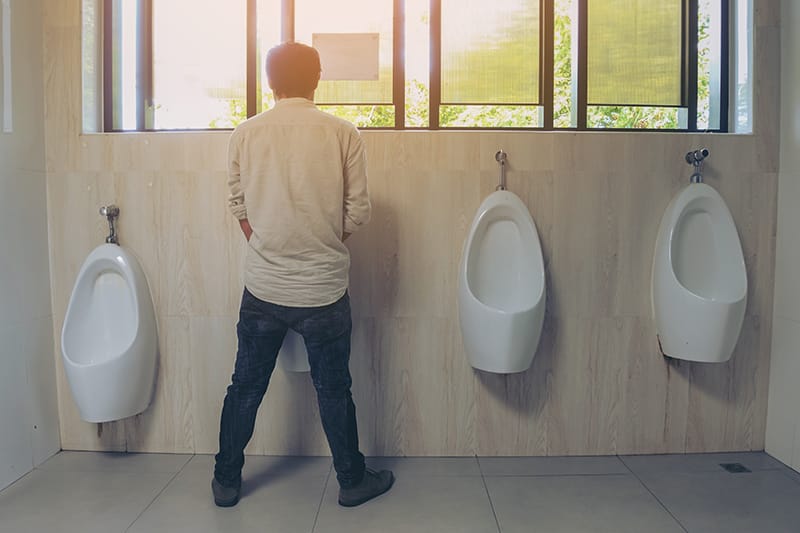While the rest of your body stops growing after puberty, your prostate kicks things back up again around the age of 25. The older you get, the bigger it grows — earning the designation of “enlarged prostate.” When the too-big prostate gland starts squeezing the urethra, you experience the troubling signs of benign prostatic hyperplasia:
You have to pee. All. The. Time.
So much so, that you’re convinced you have an alarm attached to your bladder. It goes off every hour or two, and sometimes even more at night. Frequent urination is one of the most common symptoms of an enlarged prostate.
You gotta go ... right now!
A strong urge to pee takes over you without warning. This sudden need to urinate can’t wait and you have to beeline it for the bathroom. Your urgent rushes to the restroom may be followed by further difficulties once you step inside the stall.
Your flow is all off.
You used to have the power to cut through a urinal cake like a knife through butter. But now, your urination is reduced to a weak, slow trickle that you struggle to accurately aim into a large toilet bowl. Other times, your bathroom break is full of starts, stops and delays that are out of your control.
You can never empty your bladder.
Whether it’s true or not makes no difference. Just the feeling that you cannot fully empty your bladder is discomforting. It brings you back to the men’s room sooner and more frequently in search of relief.
It’s hard to pee.
You have difficulty starting or stopping. In between, you have to push and strain just to get every little drop of urine out. In some cases, it is beyond difficult or even painful. And nothing comes out at all. That’s cause for emergency. You must get treatment ASAP.
What’s a guy to do about an enlarged prostate?
Potty humor aside, benign prostate hyperplasia is nothing to laugh about. These symptoms are not only discomforting; they can be damaging. Many of them are actually signs of changes the enlarged prostate has already caused in your bladder. Left unchecked, your urine gets backed up and irritates the bladder, leading to urinary tract infections, bladder stones and other complications.
Don’t hide your issues out of embarrassment. An enlarged prostate is completely normal. It’s just a sign of aging. That’s a comforting fact. While there’s no cure for BPH, you can manage the symptoms to keep your problems under control.
Talk to your doctor as soon as you notice the signs of BPH. After a thorough medical history, focused physical exam and lab tests, your physician can diagnose the issue and find the right treatment. Depending on the severity of your symptoms, your treatment may include:
- Watchful waiting – Caught early, your condition may not cause you much trouble. You and your physician will stay on the lookout for changes in symptoms and figure out how best to treat it.
- Lifestyle changes – As you’re watching and waiting, you can try some adjustments to your diet — mainly your fluids. Drinking fewer liquids, especially before bedtime, can ease your frequency and urgency. Cutting down on coffee and alcohol may also help, as those beverages make those two symptoms worse.
- Medication – When lifestyle changes aren’t enough, your doctor may prescribe drugs to relax the prostate and bladder, shrink the gland and prevent additional growth — or both. Medications are helpful, but you’ll have to take them forever to maintain the effects.
- UroLift® System – Meds may provide inadequate relief or leave you with unwanted side effects. The UroLift System is a minimally-invasive procedure that lifts your enlarged prostate out of the way and holds it there so it doesn’t block the urethra. You recover symptom-free and faster than the next option
- Rezum™ – This non-surgical outpatient procedure uses natural energy stored in water vapor to shrink excess prostate tissue while preserving sexual function. There are no incisions, no general anesthesia, and most patients return to regular activities within a few days.
- Thermotherapy – This procedure uses heat energy to basically microwave your prostate. Giving the gland the high heat destroys tissue so it doesn’t weigh so heavily on your urethra. There’s a longer recovery time than the UroLift System, but it’s less invasive than surgical alternatives.
- Surgery – Transurethral resection of the prostate is reserved for the biggest and baddest prostates and vaporizes obstructing tissue— with lasers! It’s the most common surgery to resolve benign prostate hyperplasia.
When your health issues are below the belt, treatment is a scary thought. But there’s more to fear from letting your pee problems go unchecked than seeking medical help for an enlarged prostate. Set your fears and embarrassment aside and consult a health care professional so that you actually feel relieved the next time you relieve yourself.
